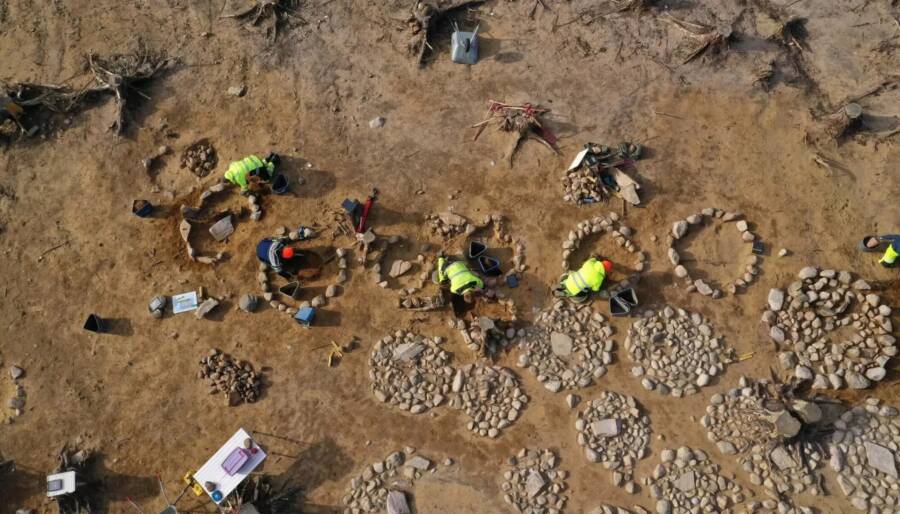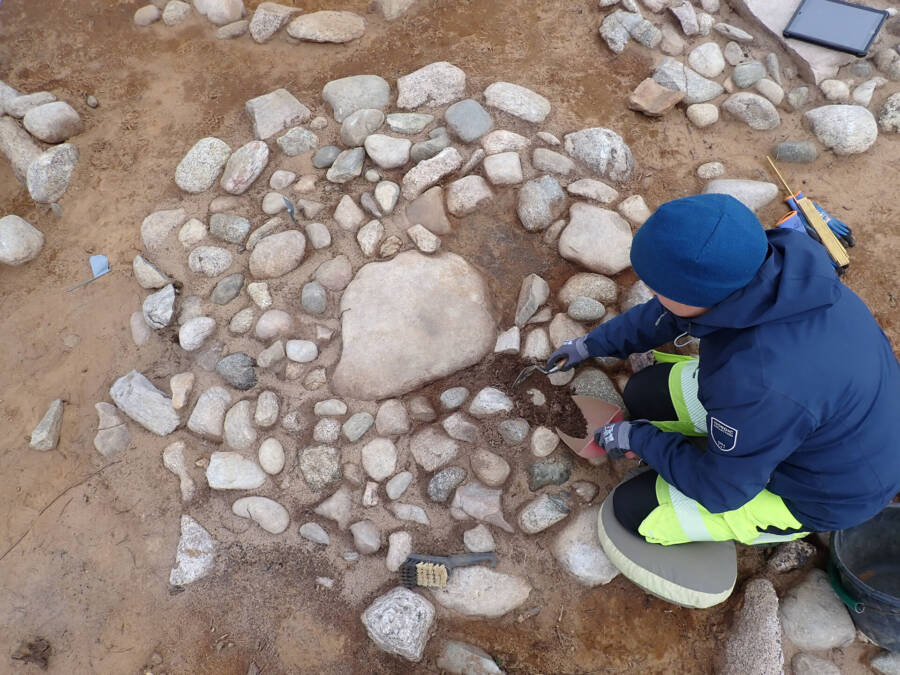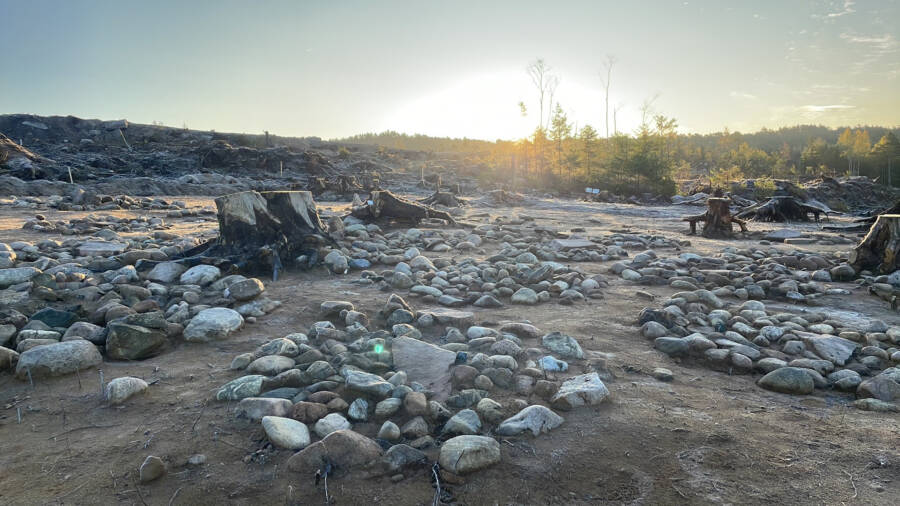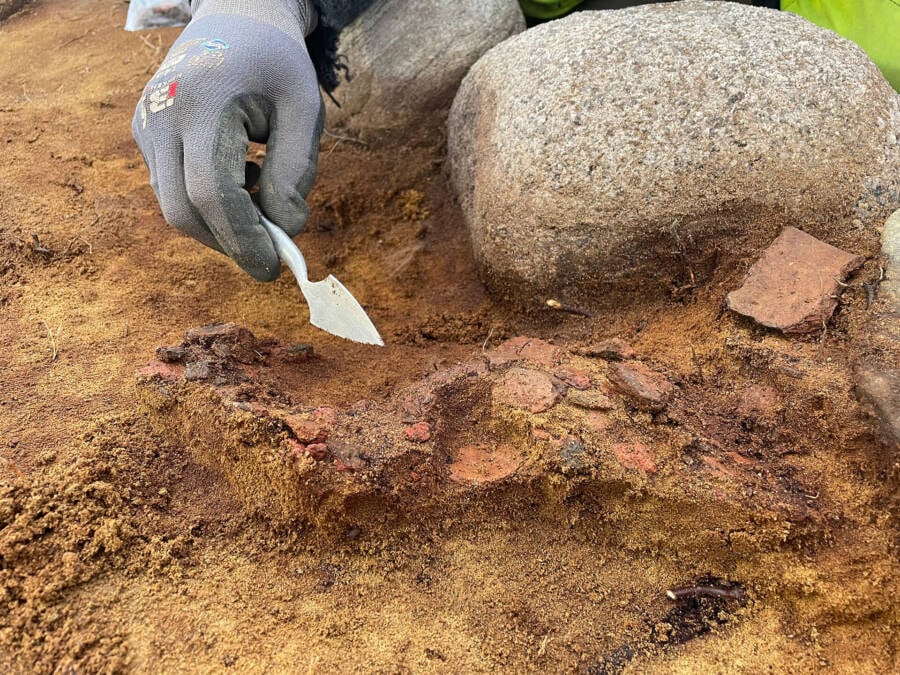The site was used for several hundred years, from the Bronze Age to the Iron Age.

Guro Fossum/Museum of Cultural History, University of OsloThe graves were initially hidden from view, just a few inches below the surface.
Last autumn, a team of archaeologists uncovered something strange near Fredrikstad, Norway: a cluster of 41 circles of meticulously placed stones. These formations were laid close together, almost like cobblestone. However, it was what lay beneath the stones that truly piqued the researchers’ interest.
These stones served as grave markers for ancient remains. And this was no ordinary graveyard: All but two of those interred were children under the age of six.
39 Stone Circle Graves Containing Children’s Remains
Archaeologists first discovered the field of graves in the fall of 2023, during an excavation in the municipality of Fredrikstad ahead of the planned expansion of a quarry there. The announcement of this discovery comes after a recent analysis of the burnt bones recovered from the site.
The burials were not initially visible in the terrain. It was only after researchers removed the turf and cleaned the area that they discovered the stone formations just a few inches below the surface.
Most of the formations were circular or ovular in shape, ranging from roughly three to six-and-a-half feet in diameter. A few also had clear edge stones and a central flagstone.

Guro Fossum/Museum of Cultural History, University of OsloResearchers examining the circular grave markers.
“We thought these must be graves,” excavation leader Guro Fossum told Science Norway.
The graves were notably well preserved, allowing for an in-depth analysis that revealed the site’s long history.
“They’ve lain here as a secret until we found them,” Fossum said. “We uncovered one after another and ended up with 41 round stone formations.” Fossum also added that she felt there was “something special” about the site.

Guro Fossum/Museum of Cultural History, University of OsloThe graves contained burnt bone remains, among other items.
“They must have been in an open landscape, with thoroughfares nearby, so everyone would have known about them,” she said. “Cooking pits and fireplaces around the site suggest that gatherings and ceremonies were held in connection with burials. Additionally, all the graves were so nice and meticulously crafted. Each stone was sourced from a different location and placed precisely in the formation. We wondered who put in so much effort.”
According to the analysis, the burial site was in use for several hundred years between the Bronze and Iron Ages, with most of the graves dating to between 800 and 200 B.C.E.
“The dating shows that the burial site was used over a long period, so they couldn’t all have died in the same natural disaster or outbreak of disease or epidemic,” Fossum said.
Even more shocking was the revelation that 39 of the people buried at the site were under the age of six when they died, many of which were infants. Now, researchers are working to determine just why the children were buried separately.
The Norwegian Museum Plans To Open An Exhibition To Honor The Dead Children
In the wake of this discovery, the Museum of Cultural History in Oslo announced that it would be installing a permanent exhibition entitled In Memory of the Children. The installation will feature a reconstruction of one of the stone formations, along with other items from the site.

Guro Fossum/Museum of Cultural History, University of OsloArchaeologists working at the site.
With analysis of the bones now complete, archaeologists say the next step is to conduct an analysis of the various grave goods found during the excavation, including pottery shards and an artifact that may be a brooch.
“Analyses of the pottery fragments can tell us a lot. It doesn’t appear that all the vessels were containers for burnt bones; some were placed between the graves, and we are very curious about what was inside them,” Fossum said.

Guro Fossum/Museum of Cultural History, University of OsloA piece of pottery uncovered from the grave.
There are also plenty of unanswered questions the archaeologists hope to answer, including why the children were buried in a separate place, why this location was chosen, and how that tradition managed to stay in place for several hundred years.
“We don’t know what kind of beliefs they had, why the dead were burned and buried. It’s possible that they believed the body had to be destroyed and transformed through fire to release the soul,” Fossum said. “Maybe these traditions and rituals were meant to honour and remember those who had died. We do the same now: We remember those who lived before us with rituals and memorials.”
After reading about this macabre discovery, learn all about the strange, mummified bog bodies found across Europe. Or, learn more about Norwegian history by reading about Harald Hardrada, the last Viking king.





